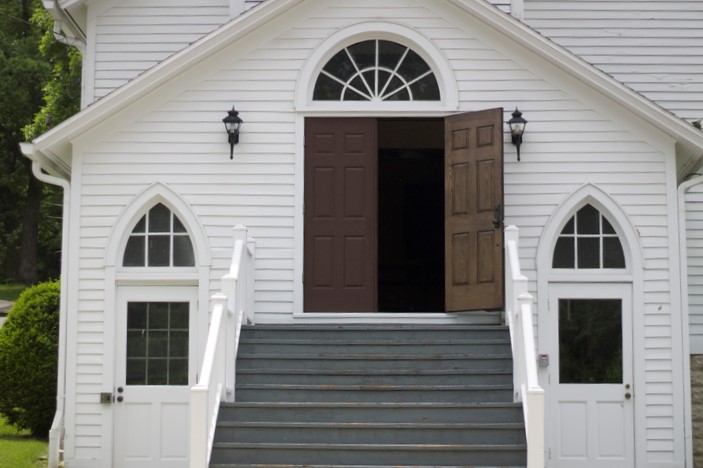
By Leiza McKenna
Most faith leaders understand how important it is to protect their house of worship from theft, vandalism or damage due to adverse weather conditions. But the physical building is not your only asset — you likely have priceless artifacts inside your building that need special protection, as well. Fine art, antiques, stained glass and religious items all have value, and in many cases, require very different care from the other items in your facility.
Protect from theft
Having a quality security system is one of the best ways to protect the valuable items in your church from theft. You should consider:
- Installing video cameras outside doors to monitor who enters the facility.
- Using burglar alarms to provide around-the-clock, remote protection.
- Acquiring motion sensors, which can alert you to any unwanted activity in your facility.
Proper storage
Fine art has a special and unique quality that requires it to be handled differently from other items. When worship services are over, you should move any artifacts that were used to a special place, so they remain in pristine condition for their next use. When deciding where you should store these items, remember to:
- Keep them off the floor. Use pallets or shelving to elevate any valuable items. This is important not only due to threat of flooding, but also because water can sometimes seep into buildings through floors.
- Watch the level of moisture in the storage area. Humidity can warp wood and ruin parchment and other fragile types of paper. It also can affect paintings and other pieces of art.
- Keep the storage area temperature controlled. If you store your important pieces in the attic or basement, research the temperature at which your fine art should be stored. If you cannot afford to add full heating to a room, you may want to add insulation instead.
- Thoroughly investigate off-site storage facilities before renting or buying them. Make sure your chosen facility is not located in an area susceptible to theft, flooding or fire.
Safe transportation
Whenever you need to move your artifacts and fine art, do so with care. Even seemingly routine trips — such as moving a religious artifact from one church to another — can damage precious items. Research the appropriate ways to pack and move each artifact, and when you need to hire someone for a big move, use a reputable art packer and mover.
Protect from the elements
Mother Nature can wreak havoc with your fine art and religious items, which is why you need to be careful that you display and store them in an environment that won’t cause damage.
Temperature — For most pieces of art, a stable, cool temperature is best. Try to keep the temperature between 65- and 75-degrees Fahrenheit.
Light — Sunlight contains ultraviolet light, which harms all work on paper, some metals and fabrics. Do not hang framed artwork on a wall that receives direct sunlight.
Humidity — You should keep your art in an area that has a humidity of 40 to 50 percent. It’s important to keep your humidity constant, and not allow it to fluctuate.
Inventory, appraisal and insurance
If you want to protect your house of worship’s precious possessions, the first step is to create a detailed inventory of every piece of fine art and artifact you have — including items of historical significance and those that are from other countries. Creating this inventory can be a tedious job, but it’s necessary to take stock of everything you own that has some worth. Then, hire an appraiser who can sort through the items to determine which pieces are of significant value. In general, any item worth more than $500 is considered significant.
Finally, talk to your insurance agent to determine whether you have enough coverage to compensate your house of worship for any loss it may incur. When performing your inventory, you might determine you have enough valuable items that you require a special fine arts rider on your insurance policy.
Protecting your precious artifacts and fine arts is an important part of your house of worship’s risk management strategy. Just imagine the loss — both sentimental and monetary — if something happened to any one of these pieces.
Leiza McKenna has more than 20 years of experience in the insurance and fine arts industries. She has combined her extensive training in the areas of art appraisal and consulting, risk management and property claims. Through multiple roles in these industry segments, Leiza has established a professional focus of supporting clients in managing and protecting their assets. She currently owns her own appraisal firm, based in Dallas, Texas. She also developed and runs the fine arts program for Church Mutual Insurance Company, S.I. (a stock insurer)1 based in Merrill, Wisconsin. At Church Mutual, Leiza assists policyholders’ to properly identify their fine arts, provide options to insure those pieces and save loss claims. As an added value, she reviews independent appraisals and helps educate policyholders on the value of their fine arts.
Her education includes the New York University Appraisal Studies in Fine and Decorative Arts program and a Bachelor of Arts degree from Xavier University. She is a member of the Appraisers Association of America.
With a specialized interest in African-American fine art and religious art/objects, Leiza is energized by her passion and by the satisfaction derived from assisting clients with understanding the value of their collections.


